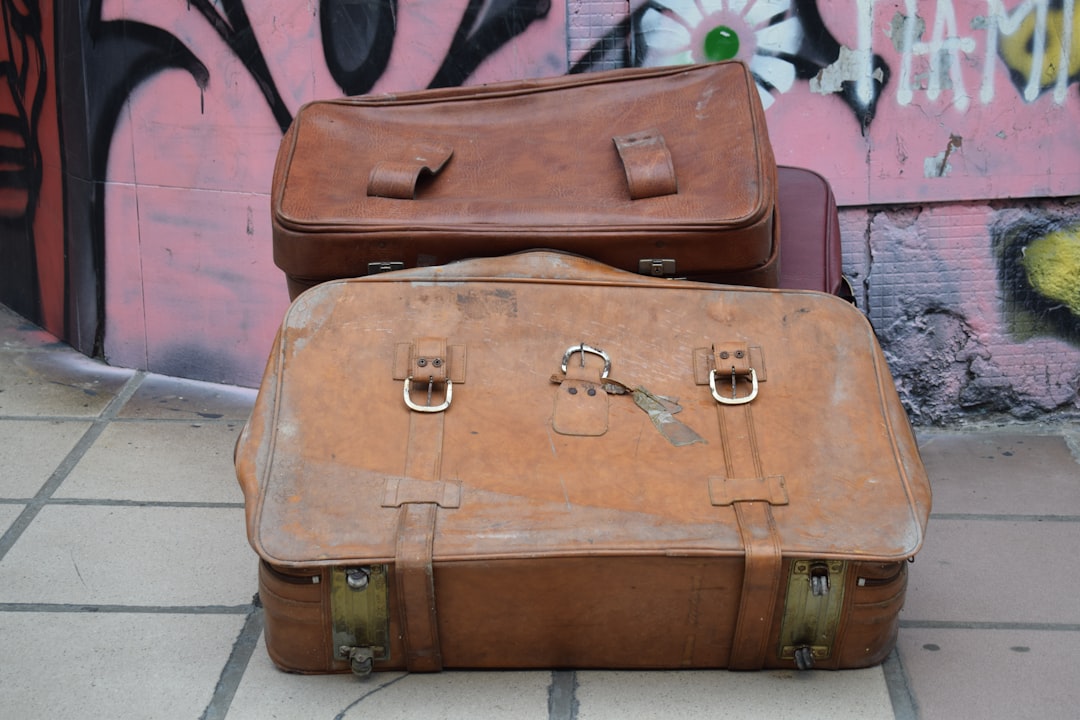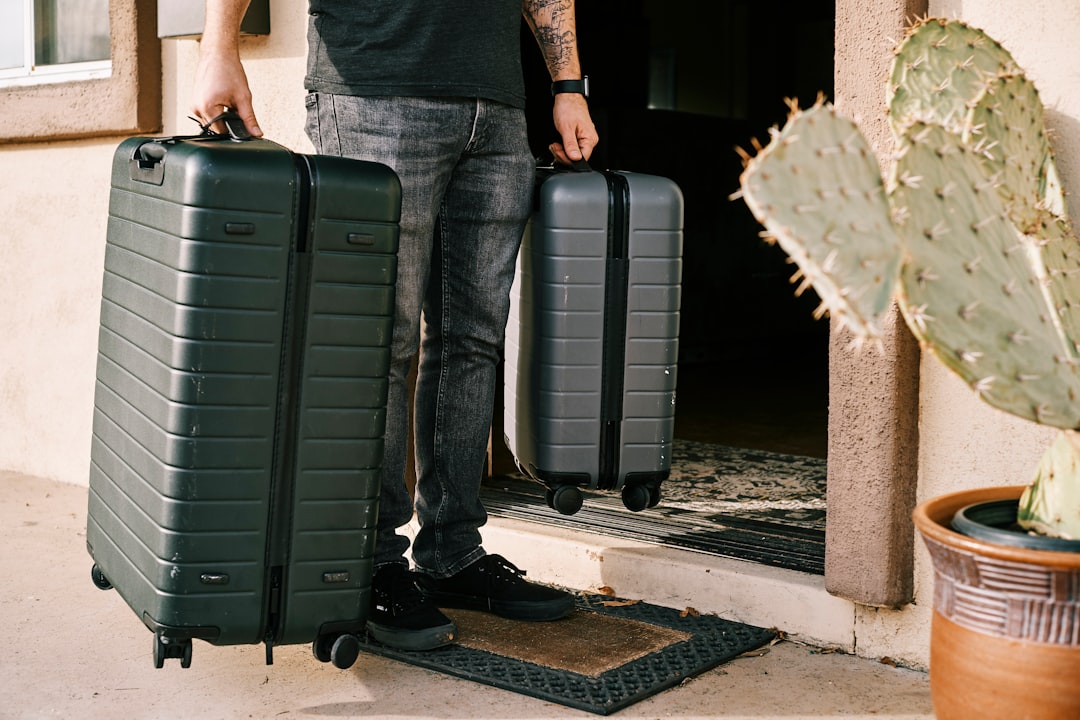
Supercharge your lead generation with a FREE Google Ads audit - no strings attached! See how you can generate more and higher quality leads
Get My Free Google Ads AuditFree consultation

No commitment
Supercharge your lead generation with a FREE LinkedIn Ads audit - no strings attached! See how you can generate more and higher quality leads
Get My Free Google Ads AuditFree consultation

No commitment
Supercharge your lead generation with a FREE Meta Ads audit - no strings attached! See how you can generate more and higher quality leads
Get My Free Google Ads AuditGet My Free LinkedIn Ads AuditGet My Free Meta Ads AuditFree consultation

No commitment
Supercharge your lead generation with a FREE Google Ads audit - no strings attached! See how you can generate more and higher quality leads
Get My Free Google Ads AuditFree consultation

No commitment
In today's complex marketing landscape, effective B2B marketing for luggage carrier services requires a strategic mix of both online and offline channels working together. Online channels like social media build digital brand awareness, email marketing nurtures ongoing relationships, and SEO drives organic visibility. Meanwhile, offline channels such as trade shows generate face-to-face connections and direct mail creates tangible touchpoints. Within this integrated ecosystem, Google Ads plays a critical middle-funnel role by capturing high-intent prospects at the exact moment they're searching for solutions—effectively bridging the gap between broader awareness efforts and your sales process. For luggage carrier industry businesses, Google Ads represents a powerful opportunity by intercepting decision-makers at the precise moment of their need, targeting with precision based on specialized terminology unique to the industry, and measuring ROI completely by tracking from click to closed deal. Complement other channels through remarketing to digital audiences alike.

Luggage carrier services operate in a fast-moving market where qualified leads are critical for sustained growth. High-performing revenue teams rely on precise audience intelligence and actionable data to connect with business travelers, relocation coordinators, and frequent flyers who value convenience and reliability.
This playbook delivers a proven, data-driven approach for integrating Google Ads into your multi-channel strategy, helping you capture demand efficiently and convert high-value prospects. Each section provides tactical guidance to unify your digital marketing efforts, accelerate lead quality, and drive measurable ROI.
This resource is designed for B2B marketers, service providers, and local operators seeking efficient, scalable, and tech-savvy solutions for online marketing in the travel and luggage carrier space. Each section offers clear, actionable strategies to help you generate qualified leads and maximize the impact of your digital marketing investment. If you’re ready to experience the benefits firsthand, get started for free with Sona.

Modern luggage carrier services operate in a market defined by rapid shifts in traveler intent and highly specialized buyer journeys. Google Ads empowers these businesses to intercept high-value prospects at precise moments—whether an executive is searching for luggage shipping before a conference or a family is planning international travel and requires reliable transport for their bags.

To make the most of these campaign types and boost your pipeline, get started for free with Sona.
Targeted growth in luggage carrier services requires an agile, data-driven approach to uncovering new demand pockets and expanding reach beyond traditional marketing channels. B2B revenue teams gain a competitive edge by integrating advanced analytics, real-time intent signals, and dynamic audience segmentation to inform campaign strategy and budget allocation.
Revenue teams that unify behavioral, intent, and CRM data create a flywheel: new growth opportunities are surfaced, engaged, and measured with precision, fueling sustained pipeline acceleration in the competitive landscape of luggage carrier services. To see how these strategies can accelerate your pipeline, get started for free with Sona.
Audience segmentation is the key to unlocking higher conversion rates and more relevant marketing outcomes in the luggage carrier industry. When targeting business travelers, vacationers, or international shipping clients, precise segmentation ensures marketing messages match each prospect’s unique needs, making your campaigns more cost-effective and scalable. For deeper insights on optimizing segmentation and targeting, explore the ultimate guide to account-based marketing.
Ready to transform your segmentation and campaign performance? Get started for free with Sona.

| Industry | Keyword | Monthly Search Volume | Competition Level | Low Bid | High Bid |
| Luggage Carrier Services | luggage carrier services | 10 | HIGH | 2.36 | 9.29 |
| Luggage Carrier Services | thule cargo box near me | 50 | HIGH | 0.82 | 2.07 |
| Luggage Carrier Services | best cargo carrier | 170 | HIGH | 0.42 | 1.55 |
| Luggage Carrier Services | large cargo carrier | 170 | HIGH | 0.23 | 0.98 |
| Luggage Carrier Services | cargo carrier near me | 260 | HIGH | 0.19 | 0.77 |
| Luggage Carrier Services | luggage car carrier | 2900 | HIGH | 0.2 | 0.58 |
| Luggage Carrier Services | check in luggage | 6600 | HIGH | 0.5 | 3.36 |
Luggage carrier services operate in a market where user intent is clear and time-sensitive. Prospects searching for solutions to ship, store, or move luggage are often ready to transact, making keyword selection a high-stakes process. The most successful revenue teams invest in keyword intelligence to intercept these buyers precisely when they are most motivated to engage and convert.
A well-calibrated keyword strategy for Google Ads unlocks measurable ROI and campaign clarity. By segmenting queries into competition and volume quadrants, marketers can allocate budget to the right terms and anticipate acquisition costs. This approach elevates digital marketing for travel, luggage transport advertising, and online marketing for luggage carriers, ensuring no opportunity is left untapped. For additional insight into campaign optimization, explore best practices for Google Ads in health care.
When using the keyword quadrant chart, marketers should prioritize high-volume, low-competition terms like "luggage courier service near me" for cost-effective Google Ads strategies. These keywords are often underutilized by competitors and deliver strong ROI when combined with real-time intent data. High-volume, high-competition terms such as "airport luggage shipping" require higher bids but bring in substantial traffic from in-market buyers who are closest to a decision. Low-volume, high-competition keywords like "luxury luggage delivery" may be best reserved for specialized campaigns targeting premium segments. Meanwhile, low-volume, low-competition terms like "eco-friendly luggage moving" are ideal for targeted testing, niche offerings, or local service ads for carriers seeking to establish authority in emerging areas.
By aligning keyword strategy with real-time behavioral data and dynamic audience segments, revenue teams in luggage carrier services can ensure every search campaign is both cost-efficient and conversion-focused. This enables more accurate forecasting of Google Ads budget for services and sharpens the ability to target customers with Google Ads who are most likely to become high-value accounts. To experience the benefits firsthand, get started for free with Sona.
A successful Google Ads strategy for luggage carrier services begins with disciplined keyword research. Clustering keywords by service type, such as seasonal promotions or urgent luggage deliveries, creates a foundation for granular targeting. Add geographic modifiers like city names, neighborhoods, and “near me” to capture local search intent and drive high-intent leads from travelers looking for luggage transport solutions in real time. For more actionable marketing ideas and digital tactics, explore how to market a luggage business online. Long-tail phrases and question-based searches—examples include “how to ship luggage to airport” or “luggage delivery service near JFK”—bring in traffic further down the funnel and often at a lower cost per click. By layering negative keywords, you filter out irrelevant queries and protect spend, improving match quality and campaign efficiency.
Align these keyword lists with the language and intent already present in your content marketing. Using Sona’s Audiences tool, marketers can detect which search queries are generating not only traffic but also qualified leads. When platforms unify keyword data with real-time visitor identification, revenue teams can prioritize outreach to accounts already signaling high purchase intent, ensuring that budget is allocated to the audiences most likely to convert.
Effective ad copy for luggage carrier services speaks directly to the challenges faced by travelers and businesses: missed connections, lost bags, or last-minute shipping needs. Headlines that address these pain points—such as “Get Your Bags Delivered Same Day” or “Avoid Airline Baggage Fees”—immediately resonate with prospects. Integrate urgency into every ad by featuring limited-time discounts, guaranteed delivery windows, or bundle offers. Extensions including call buttons, structured snippets, and quick service highlights improve visibility and make it easier for users to engage directly from the search results.
Modern ad platforms can leverage advanced Sona’s Intent Signals feature from unified data sources, enabling marketers to tailor copy dynamically based on the user’s stage in the funnel. When you harness behavioral insights from in-market activity, you can automatically adjust messaging to capture leads at the optimal moment. For direct inspiration, view this video case study on Google Ads for luggage brands. As audiences progress or re-engage, refreshed creative and tailored offers keep your brand top of mind and drive higher rates of action.
Landing pages tailored for luggage carrier services must create a seamless journey from ad click to conversion. Ensure a one-to-one alignment between keyword, ad, and landing page content—visitors searching for “urgent luggage shipping” should land on a page emphasizing speed, while those seeking “luggage services for international travelers” should find detailed information relevant to global transport. Segment pages by service or vertical to maximize relevance. Implement ROI calculators, trust badges, and comprehensive FAQs to build credibility and reduce friction in the decision process. Calls-to-action should be prominent, persistent as users scroll, and optimized for mobile to support on-the-go bookings.
Integrating forms with your CRM and Sona’s Destinations feature streamlines lead capture and follow-up, turning ad clicks into actionable sales opportunities. When Sona’s Ad Conversions feature is synced back into your ad platform, you can automatically refine audiences and retarget those who demonstrate high purchase intent or abandon the process. This closed-loop approach ensures that your most valuable leads receive timely, personalized engagement through every stage of the buying cycle. To experience streamlined campaign execution, get started for free with Sona.
Continuous improvement in Google Ads for luggage carrier services relies on robust measurement and iterative testing. Track both micro-conversions (such as form starts and phone clicks) and macro-conversions (completed bookings or purchases) to gain a holistic view of campaign performance. For industry benchmark data on Google Ads return on ad spend (ROAS) for luggage businesses, review Google ROAS for luggage. Smart bidding strategies like Target CPA or Max Conversions help optimize budget allocation for the greatest impact, adjusting bids in real time as new data flows in.
A/B testing should extend across ad headlines, CTA placements, and landing page layouts to identify the combinations that drive the highest engagement and conversions. Integrating offline conversion data—such as call center sales or in-person transactions—provides a more accurate picture of return on investment. When offline attribution models connect both online and offline events, marketers can recalibrate campaigns to maximize true revenue impact. This data-driven feedback loop not only sharpens your Google Ads strategy but also informs content creation and audience segmentation across all digital channels, driving sustained growth for luggage carrier services.

Luggage carrier services can elevate their digital footprint by blending thoughtful content marketing with targeted digital advertising. By aligning educational resources and value-driven messaging with high-intent user moments, these brands create touchpoints that guide prospects seamlessly from awareness to purchase. For more strategies on nurturing prospects from initial interest to conversion, visit the Sona blog.
Effective Google Ads execution in the luggage carrier services industry hinges on a foundation of smart keyword targeting, audience segmentation, and creative excellence. Brands that unify their marketing ecosystem and leverage real-time conversion data can quickly optimize bids and creative for maximum ROI. Integrating web, CRM, and sales data ensures that every touchpoint is actionable, bridging the gap between digital engagement and measurable business outcomes. To streamline your audience activation and campaign tracking, get started for free with Sona.
Navigating the intricacies of Google Ads for your luggage carrier services can be a daunting task, but with the right strategies, you can effectively stand out in a competitive market. By understanding your audience, crafting compelling ad copy, and leveraging data-driven insights, you can optimize your ad campaigns and increase visibility.
Throughout this article, we've explored the core challenges of promoting luggage carrier services through Google Ads, such as targeting the right demographics and maximizing your ROI. We've also discussed best practices, including keyword optimization and budget allocation, to help you make the most of your advertising efforts.
Imagine the possibilities when your ads consistently reach the right audience, leading to increased engagement and conversions. By implementing these proven strategies, you can transform your digital marketing approach and achieve your business goals.
To take your advertising strategy to the next level, start for free and experience our platform's capabilities today. Let us help you unify your go-to-market data and drive actionable insights for your luggage carrier services.
Effective practices include integrating Google Ads with other marketing channels, using precise audience intelligence, leveraging specialized keyword targeting, and ensuring ad and landing page alignment to address customer pain points.
Optimization can be achieved by targeting high-intent keywords, segmenting campaigns by service type or traveler profile, aligning ad copy with landing page content, and continuously using data-driven adjustments based on performance analytics.
Budget allocation should be guided by high-value keyword targeting, performance data, and integrating cross-channel strategies to ensure cost-effectiveness and maximize ROI.
Success can be measured through advanced conversion tracking, integrating online and offline actions, and calculating ROI and lifetime value to track every conversion from click to closed deal.
Focus on high-intent keywords such as 'luggage shipping service,' 'door-to-door bag delivery,' and 'airport luggage storage,' and adjust based on real-time search trends and competitive analysis.
Join results-focused teams combining Sona Platform automation with advanced Google Ads strategies to scale lead generation

Connect your existing CRM

Free Account Enrichment

No setup fees
No commitment required

Free consultation

Get a custom Google Ads roadmap for your business
Join results-focused teams combining Sona Platform automation with advanced Meta Ads strategies to scale lead generation

Connect your existing CRM

Free Account Enrichment

No setup fees
No commitment required

Free consultation

Get a custom Google Ads roadmap for your business
Join results-focused teams combining Sona Platform automation with advanced LinkedIn Ads strategies to scale lead generation

Connect your existing CRM

Free Account Enrichment

No setup fees
No commitment required

Free consultation

Get a custom Google Ads roadmap for your business
Join results-focused teams using Sona Platform automation to activate unified sales and marketing data, maximize ROI on marketing investments, and drive measurable growth

Connect your existing CRM

Free Account Enrichment

No setup fees
No commitment required

Free consultation

Get a custom Google Ads roadmap for your business
Over 500+ auto detailing businesses trust our platform to grow their revenue
Join results-focused teams using Sona Platform automation to activate unified sales and marketing data, maximize ROI on marketing investments, and drive measurable growth

Connect your existing CRM

Free Account Enrichment

No setup fees
No commitment required

Free consultation

Get a custom Google Ads roadmap for your business
Over 500+ auto detailing businesses trust our platform to grow their revenue
Join results-focused teams using Sona Platform automation to activate unified sales and marketing data, maximize ROI on marketing investments, and drive measurable growth

Connect your existing CRM

Free Account Enrichment

No setup fees
No commitment required

Free consultation

Get a custom Google Ads roadmap for your business
Over 500+ auto detailing businesses trust our platform to grow their revenue
Our team of experts can implement your Google Ads campaigns, then show you how Sona helps you manage exceptional campaign performance and sales.
Schedule your FREE 15-minute strategy sessionOur team of experts can implement your Meta Ads campaigns, then show you how Sona helps you manage exceptional campaign performance and sales.
Schedule your FREE 15-minute strategy sessionOur team of experts can implement your LinkedIn Ads campaigns, then show you how Sona helps you manage exceptional campaign performance and sales.
Schedule your FREE 15-minute strategy sessionOur team of experts can help improve your demand generation strategy, and can show you how advanced attribution and data activation can help you realize more opportunities and improve sales performance.
Schedule your FREE 30-minute strategy sessionOur team of experts can help improve your demand generation strategy, and can show you how advanced attribution and data activation can help you realize more opportunities and improve sales performance.
Schedule your FREE 30-minute strategy sessionOur team of experts can help improve your demand generation strategy, and can show you how advanced attribution and data activation can help you realize more opportunities and improve sales performance.
Schedule your FREE 30-minute strategy sessionOur team of experts can help improve your demand generation strategy, and can show you how advanced attribution and data activation can help you realize more opportunities and improve sales performance.
Schedule your FREE 30-minute strategy session





Launch campaigns that generate qualified leads in 30 days or less.
